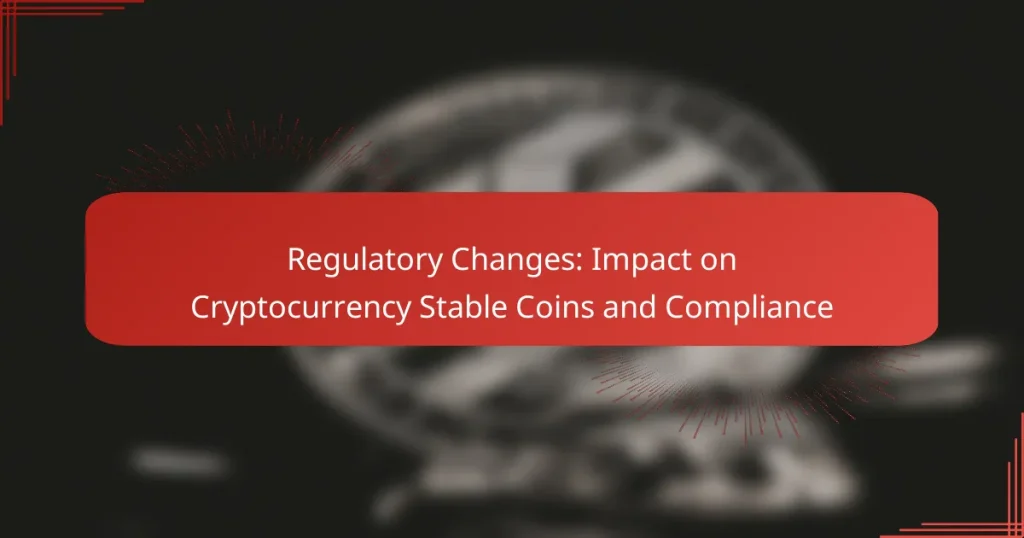Regulatory changes are reshaping the landscape of cryptocurrency stable coins by enforcing stricter compliance measures aimed at enhancing transparency and consumer protection. As issuers adapt to these new standards, particularly in areas such as Know Your Customer (KYC) and Anti-Money Laundering (AML), they face both challenges and opportunities in navigating the evolving regulatory environment. Countries like the United States and members of the European Union are leading the charge in establishing frameworks that address the complexities associated with stable coins, ensuring their integration into the broader financial system is both secure and stable.

How are regulatory changes affecting cryptocurrency stable coins?
Regulatory changes are significantly impacting cryptocurrency stable coins by introducing stricter compliance measures and altering market dynamics. These changes aim to enhance transparency and protect consumers, but they also pose challenges for issuers and users alike.
Increased compliance requirements
New regulations are imposing heightened compliance requirements on stable coin issuers, including rigorous reporting and auditing standards. Issuers may need to demonstrate that their reserves are fully backed by fiat currencies or other assets, which can lead to increased operational costs.
For example, regulations may require regular disclosures about the composition of reserves and the mechanisms used to maintain the peg to the underlying currency. This can create a barrier to entry for smaller players in the market, consolidating power among larger, more established firms.
Impact on market stability
Regulatory changes can enhance market stability by reducing the risk of fraud and ensuring that stable coins maintain their value relative to fiat currencies. However, increased scrutiny may also lead to volatility as market participants adjust to new rules and compliance costs.
For instance, if a major stable coin faces regulatory action, it could trigger a loss of confidence among users, leading to rapid sell-offs and price fluctuations. This potential instability underscores the importance of regulatory clarity in fostering a reliable environment for stable coins.
Changes in user trust
As regulations evolve, user trust in stable coins may shift significantly. Stricter compliance measures can enhance confidence among users who prioritize security and transparency, while others may view these changes as a threat to the decentralized ethos of cryptocurrencies.
To build and maintain trust, stable coin issuers should prioritize clear communication about compliance efforts and the safeguards in place to protect users’ funds. Engaging with regulatory bodies and demonstrating a commitment to compliance can also help bolster user confidence in a rapidly changing landscape.

What compliance measures are necessary for stable coin issuers?
Stable coin issuers must implement robust compliance measures to align with regulatory standards, primarily focusing on Know Your Customer (KYC) and Anti-Money Laundering (AML) practices. These measures ensure transparency and help prevent illicit activities within the cryptocurrency ecosystem.
Know Your Customer (KYC) regulations
KYC regulations require stable coin issuers to verify the identities of their customers before allowing them to transact. This process typically involves collecting personal information such as name, address, date of birth, and government-issued identification.
Issuers should establish a systematic approach to KYC, including risk assessment protocols. For example, high-risk customers may require enhanced due diligence, which could involve more thorough background checks and ongoing monitoring of transactions.
Anti-Money Laundering (AML) practices
AML practices are essential for stable coin issuers to detect and prevent money laundering activities. This includes implementing transaction monitoring systems that flag suspicious activities based on predefined criteria, such as transaction size or frequency.
Issuers should also maintain comprehensive records of transactions and customer interactions to comply with regulatory requirements. Regular audits and staff training on AML compliance can further strengthen their defenses against financial crime.

Which countries are leading in stable coin regulation?
Countries such as the United States and members of the European Union are at the forefront of stable coin regulation, implementing frameworks to ensure compliance and consumer protection. These regulations aim to address the unique challenges posed by stable coins, including their potential impact on financial stability and monetary policy.
United States regulatory frameworks
The United States has a fragmented regulatory approach to stable coins, with various agencies like the SEC and CFTC overseeing different aspects. Currently, there is no single federal law governing stable coins, but proposed legislation aims to create a clearer framework that includes consumer protections and anti-money laundering measures.
Key considerations for stable coin issuers in the U.S. include compliance with existing securities laws and potential registration requirements. Companies must also be prepared for ongoing scrutiny regarding their reserves and operational transparency.
European Union’s MiCA legislation
The European Union’s Markets in Crypto-Assets (MiCA) legislation is set to standardize the regulatory landscape for stable coins across member states. This comprehensive framework will require stable coin issuers to obtain licenses and adhere to strict operational and transparency standards, including maintaining sufficient reserves.
Under MiCA, stable coins will be classified based on their characteristics, with additional requirements for those deemed significant to financial stability. This regulation aims to foster innovation while ensuring consumer protection and financial integrity within the EU market.

What are the risks of non-compliance for stable coin platforms?
Stable coin platforms face significant risks if they fail to comply with regulatory standards. These risks can lead to severe legal consequences, loss of business opportunities, and damage to reputation.
Legal penalties and fines
Non-compliance can result in hefty legal penalties and fines imposed by regulatory bodies. Depending on the jurisdiction, these fines can range from thousands to millions of dollars, significantly impacting a platform’s financial stability.
For example, in the United States, the Financial Crimes Enforcement Network (FinCEN) may impose fines for violations related to anti-money laundering (AML) regulations. Platforms should ensure they are adhering to all applicable laws to avoid such penalties.
Loss of market access
Failure to comply with regulations can lead to a loss of market access, restricting a stable coin platform’s ability to operate in certain regions. This can occur if regulators revoke licenses or impose bans on trading activities.
For instance, a stable coin platform that does not meet the European Union’s Markets in Crypto-Assets (MiCA) regulations may be barred from offering services within EU member states. Maintaining compliance is crucial for sustaining market presence and customer trust.

How can stable coin projects adapt to regulatory changes?
Stable coin projects can adapt to regulatory changes by establishing comprehensive compliance frameworks and actively engaging with regulatory bodies. This proactive approach helps ensure that projects remain aligned with evolving legal requirements and market expectations.
Implementing robust compliance systems
To navigate regulatory changes effectively, stable coin projects should implement robust compliance systems that include thorough risk assessments and regular audits. These systems should be designed to monitor transactions, verify user identities, and ensure adherence to anti-money laundering (AML) and know your customer (KYC) regulations.
Projects can benefit from adopting industry standards, such as the Financial Action Task Force (FATF) guidelines, which provide a framework for compliance. Additionally, utilizing technology solutions like blockchain analytics can enhance monitoring capabilities and facilitate timely reporting to authorities.
Engaging with regulators
Active engagement with regulators is crucial for stable coin projects to understand the regulatory landscape and influence policy development. Establishing open lines of communication can help projects clarify compliance expectations and address potential concerns before they escalate.
Participating in industry forums and consultations can also provide valuable insights into upcoming regulations. Projects should consider forming alliances with other stakeholders to present a unified voice, which can strengthen their position in discussions with regulators.

What are the future trends in stable coin regulation?
Future trends in stable coin regulation will likely focus on establishing clearer guidelines, enhancing interoperability with traditional financial systems, and ensuring consumer safety. As governments and regulatory bodies worldwide adapt to the growing influence of stable coins, compliance frameworks will evolve to address risks and promote stability.
Emerging global standards
Emerging global standards for stable coins aim to create a cohesive regulatory environment that transcends national boundaries. Organizations like the Financial Stability Board (FSB) are working to develop frameworks that ensure stable coins adhere to principles of transparency, accountability, and risk management.
Countries may adopt similar regulatory approaches, which could include requirements for reserves, regular audits, and clear governance structures. This alignment can help facilitate cross-border transactions and enhance trust among users.
Integration with central bank digital currencies (CBDCs)
The integration of stable coins with central bank digital currencies (CBDCs) is a significant trend shaping the future of digital finance. As central banks explore CBDCs, stable coins may serve as a bridge between traditional fiat currencies and digital assets, enhancing liquidity and transaction efficiency.
This integration could lead to new payment systems that leverage the benefits of both stable coins and CBDCs, potentially reducing transaction costs and increasing accessibility for consumers. However, regulatory clarity will be crucial to ensure that these systems operate smoothly and securely.
Increased focus on consumer protection
As stable coins gain popularity, regulators are placing a heightened emphasis on consumer protection. This includes ensuring that users are informed about the risks associated with stable coins, such as volatility and the potential for loss of funds.
Regulatory measures may involve mandating disclosures, implementing safeguards against fraud, and establishing mechanisms for dispute resolution. Consumers should stay informed about the regulatory landscape and choose stable coins that comply with these emerging standards to mitigate risks.


